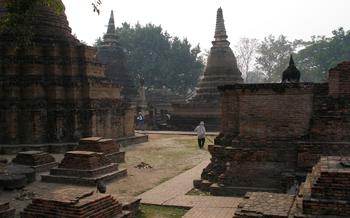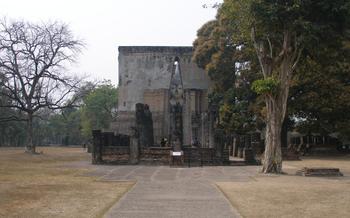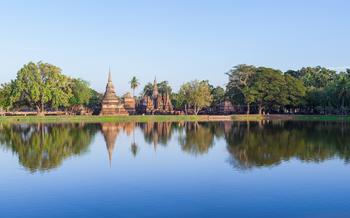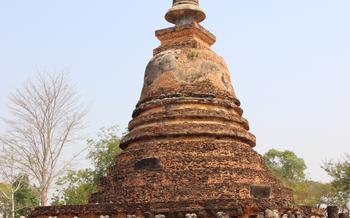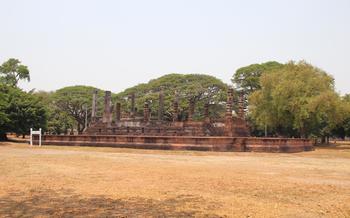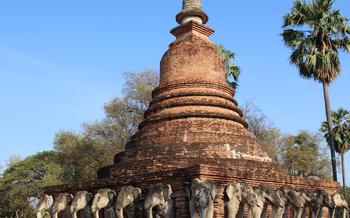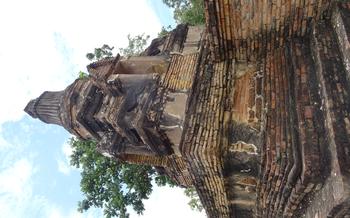
Wat Thung Saliam
- The Ruins of Wat Thung Saliam:
- Historical Significance:
- Architectural Features:
- Location and Accessibility:
- Must-See Highlights:
- Exploring the Ordination Hall
- Admiring the Buddha Images:
- Strolling Through the Temple Grounds
- Experiencing the Local Culture:
- Visiting the Nearby Village
- Participating in Meditation Sessions
- Learning About Buddhism:
- Exploring Other Temples Nearby
- Dressing Appropriately
- Observing Temple Etiquette
- Taking Memorable Photos
- Enjoying Local Cuisine
- Insider Tip:
The Ruins of Wat Thung Saliam:
Amidst the rolling hills and lush greenery of Sukhothai, Thailand, stands the ancient and awe-inspiring Wat Thung Saliam, a testament to the rich history and vibrant culture of the region. Dating back to the 13th century, this ruined temple complex offers visitors a glimpse into the architectural wonders and spiritual significance of the Sukhothai Kingdom.
Historical Significance:
Wat Thung Saliam holds immense historical value as one of the earliest Buddhist temples constructed during the Sukhothai era. Founded by King Ramkhamhaeng the Great, the temple served as a religious and cultural center for the kingdom and played a pivotal role in the spread of Buddhism throughout the region.
Architectural Features:
The ruins of Wat Thung Saliam showcase the distinctive architectural style of the Sukhothai period, characterized by elegant lines, graceful curves, and intricate ornamentation. The temple features a series of stupas, or bell-shaped structures, adorned with delicate stucco reliefs depicting scenes from Buddhist mythology.
Location and Accessibility:
Situated approximately 15 kilometers from the city of Sukhothai, Wat Thung Saliam is easily accessible by road. Visitors can explore the temple grounds on foot or rent bicycles to immerse themselves in the tranquil surroundings.
Must-See Highlights:
Wat Thung Saliam offers several must-see highlights, including the towering main stupa, which stands as a symbol of the temple's grandeur. The ordination hall, with its beautifully preserved murals, provides a glimpse into the artistic and religious traditions of the Sukhothai era. Visitors can also admire the numerous Buddha images scattered throughout the temple grounds, each with unique characteristics and spiritual significance.
Exploring the Ordination Hall
The Ordination Hall, also known as the Ubosot, is the most sacred structure within the temple complex. It is characterized by its distinctive architectural design, featuring a high, steeply pitched roof that symbolizes the peak of Mount Meru, the mythical abode of the gods in Buddhist cosmology. The intricate murals adorning the interior walls depict scenes from the life of Buddha and various Jataka tales, providing a visual narrative of his teachings and exemplary life.
The Ordination Hall holds immense historical significance as it serves as the venue for various religious ceremonies, including ordinations, where young men officially become Buddhist monks. It is also a place where monks gather for daily prayers and meditation sessions. The serene and contemplative atmosphere of the hall fosters a sense of spirituality and invites visitors to reflect on the teachings of Buddha and the essence of monastic life.
Admiring the Buddha Images:
Wat Thung Saliam is home to a remarkable collection of Buddha images, each possessing unique characteristics and profound symbolism. Visitors can marvel at the serene expressions and intricate details of these sacred figures, gaining a deeper understanding of Buddhist iconography. The diversity of Buddha statues, ranging from colossal standing images to smaller seated figures, offers a glimpse into the different artistic styles and periods that have shaped Thai Buddhist art.
The most striking feature of the Buddha images at Wat Thung Saliam is their serene and compassionate expressions. The gentle smiles and half-closed eyes convey a sense of inner peace and tranquility, inviting visitors to reflect on the teachings of the Buddha. The intricate details of the statues, such as the delicate drapery of their robes and the finely carved facial features, showcase the exceptional craftsmanship of Thai artisans.
Each Buddha image at Wat Thung Saliam holds a unique symbolic meaning. The standing Buddha statues, known as Phra Buddha Chinnarat, represent the Buddha's unwavering determination and strength. The seated Buddha images, known as Phra Buddha Sihing, symbolize the Buddha's teachings and his attainment of enlightenment. Visitors can learn about the different mudras, or hand gestures, of the Buddha images, each of which conveys a specific meaning or blessing.
The spiritual atmosphere at Wat Thung Saliam is palpable, as visitors are surrounded by the serene presence of the Buddha images. The temple encourages visitors to pay homage to the Buddha by offering flowers, incense, or candles. The flickering flames of the candles and the sweet fragrance of the incense create a sacred ambiance that enhances the spiritual experience of visiting the temple.
Strolling Through the Temple Grounds
As you wander through the temple grounds of Wat Thung Saliam, you'll be enveloped by a sense of tranquility and peace. The lush surroundings, with towering trees and vibrant flowers, create an idyllic setting for contemplation and reflection. The air is filled with the gentle sound of birdsong and the rustling of leaves, adding to the serene atmosphere.
Notable landmarks within the temple grounds include the bell tower, with its intricate carvings and towering spire, and the beautiful lotus pond, which reflects the surrounding greenery. Take your time to explore these landmarks and soak in the tranquil ambiance of the temple.
Don't miss the opportunity to capture the beauty of the temple grounds through photography. Whether you're a professional photographer or simply enjoy taking snapshots, you'll find plenty of photo-worthy subjects here. Just be sure to be respectful of the temple's sacred nature and avoid using flash photography.
Experiencing the Local Culture:
Visiting Wat Thung Saliam provides an immersive opportunity to delve into the vibrant local culture of Sukhothai. Engaging with the friendly monks who reside at the temple offers a unique chance to learn about their daily lives, Buddhist teachings, and the significance of the temple in the community. Participating in traditional ceremonies and festivals held at the temple allows visitors to witness firsthand the rich cultural heritage and deep-rooted traditions of the region.
The surrounding village near Wat Thung Saliam is a hub of local activity, where visitors can immerse themselves in the authentic lifestyle of the Thai people. Interacting with the villagers provides an insight into their customs, beliefs, and way of life. Exploring the market atmosphere and sampling the delicious local cuisine, including traditional desserts and street food delicacies, offers a delightful culinary adventure. For those seeking a deeper connection with the local culture, handicraft shops offer a treasure trove of unique souvenirs and handmade crafts, showcasing the artistry and skills of the talented local artisans.
Visiting the Nearby Village
Nestled near Wat Thung Saliam is a charming village that offers a glimpse into the authentic local lifestyle. Take a break from the temple's tranquility and immerse yourself in the vibrant energy of the village. Here, you'll discover a fascinating blend of tradition, culture, and everyday life.
Stroll through the narrow streets and admire the traditional wooden houses, many of which feature intricate carvings and colorful facades. Observe the locals going about their daily routines, whether it's tending to their gardens, chatting with neighbors, or selling handmade crafts.
Seek out the village's traditional artisans, who have inherited skills passed down through generations. Watch as they skillfully create intricate pottery, weave colorful textiles, or carve beautiful wooden sculptures. Support their craftsmanship by purchasing a unique souvenir to cherish as a reminder of your visit.
Indulge in the village's delectable cuisine, which showcases authentic Thai flavors and fresh ingredients. Sample the local specialties at family-run restaurants or savor the delights of street food stalls. Don't miss the chance to try the region's signature dishes, such as spicy papaya salad, northern-style curries, and sweet sticky rice with mango.
The village market is a hive of activity, where locals gather to buy and sell a variety of goods. Browse through the stalls and discover an array of fresh produce, handmade crafts, and local delicacies. Engage with the friendly vendors, who are always happy to share stories about their products and the village's history.
Immerse yourself in the vibrant atmosphere of this charming village, where the past and present harmoniously coexist. Experience the warmth and hospitality of the local people, who are proud to share their culture and traditions with visitors.
Participating in Meditation Sessions
At Wat Thung Saliam, visitors have the unique opportunity to participate in meditation sessions and learn about the art of mindfulness. Meditation is a practice that has been integral to Buddhism for centuries, and it offers numerous benefits for both physical and mental well-being. The serene ambiance of the temple provides an ideal setting for meditation, allowing participants to find inner peace and tranquility.
Guided Sessions for Beginners: Guided meditation sessions are available for both experienced practitioners and beginners. These sessions are led by experienced monks or meditation teachers who provide clear instructions and guidance, making them suitable for those who are new to the practice. The sessions typically begin with simple breathing exercises to help participants relax and focus their minds, followed by guided meditations that focus on specific themes such as compassion, loving-kindness, or gratitude.
Enhancing Spiritual Connection: Participating in meditation sessions at Wat Thung Saliam offers a profound opportunity for spiritual growth and self-discovery. Meditation helps to cultivate mindfulness, awareness, and compassion, leading to a deeper understanding of oneself and the world around. It allows individuals to connect with their inner selves, find inner peace, and develop a stronger connection to the teachings of Buddhism.
Learning About Buddhism:
Wat Thung Saliam offers a unique opportunity to delve into the profound teachings of Buddhism. The temple serves as a center for learning and spiritual growth, providing visitors with insights into the fundamental principles of this ancient religion. Through guided tours, meditation sessions, and interactions with knowledgeable monks, visitors can explore the rich history, philosophy, and cultural influences that have shaped Buddhism over the centuries. Discover the Four Noble Truths, the Eightfold Path, and the concept of karma, gaining a deeper understanding of the Buddhist perspective on life, suffering, and the path to enlightenment.
Exploring Other Temples Nearby
Beyond the captivating allure of Wat Thung Saliam, the surrounding area offers a treasure trove of additional temples that beckon you to embark on a journey of spiritual discovery. Each of these sacred sites possesses a unique charm, showcasing diverse architectural styles, awe-inspiring Buddha images, and profound historical significance.
-
Wat Si Chum: Renowned for its colossal Buddha statue, known as Phra Achana, this temple captivates visitors with its serene atmosphere and intricate artwork.
-
Wat Mahathat: Step into the hallowed grounds of Wat Mahathat, where ancient ruins and towering stupas stand as testaments to the grandeur of the Sukhothai Kingdom.
-
Wat Chang Lom: Experience the playful spirit of Wat Chang Lom, adorned with enchanting elephant sculptures that lend a whimsical touch to this sacred space.
-
Wat Sri Sawan: Immerse yourself in the tranquility of Wat Sri Sawan, known for its serene lake and graceful Buddha images that exude an aura of peace and serenity.
Exploring these neighboring temples not only enriches your understanding of Sukhothai's rich cultural heritage but also provides an opportunity to delve deeper into the diverse expressions of Buddhist architecture and spirituality.
Dressing Appropriately
When visiting temples in Thailand, it is crucial to dress respectfully to honor local customs and traditions. While the dress code is not strictly enforced, it is advisable to wear modest and appropriate attire. Covering your shoulders and knees is essential, so avoid wearing shorts, tank tops, or revealing clothing. Opt for lightweight, loose-fitting garments that allow for comfortable movement and ventilation. Consider carrying a scarf or sarong to cover up if needed. Bright colors and flashy patterns are generally not considered appropriate for temple visits. It is best to choose neutral tones and simple designs that blend in with the serene atmosphere. By dressing respectfully, you show reverence for the sacred space and demonstrate your understanding of local customs, creating a positive and harmonious experience for all.
Observing Temple Etiquette
When visiting Wat Thung Saliam, it is crucial to observe proper temple etiquette to show respect for the sacred space and the monks who reside there. Here are some essential guidelines to follow:
-
Be respectful of monks and Buddha images: Refrain from touching or pointing at monks or Buddha images. Always maintain a respectful distance and avoid any actions that may be perceived as disrespectful.
-
Avoid loud noises and distractions: Temples are places of tranquility and meditation; therefore, it is essential to maintain a peaceful environment. Avoid talking loudly, laughing, or engaging in activities that may disturb others.
-
Dress appropriately: As a sign of respect, visitors should dress modestly when visiting temples. Avoid wearing shorts, tank tops, or revealing clothing. It is customary to remove shoes before entering the temple's sacred areas.
-
Be mindful of your behavior: Refrain from engaging in disrespectful or inappropriate behavior such as smoking, chewing gum, or using foul language. Temples are sacred spaces where visitors should strive to maintain a respectful and contemplative demeanor.
By observing proper temple etiquette, visitors can contribute to preserving the sanctity of Wat Thung Saliam and ensure a peaceful and enjoyable experience for all.
Taking Memorable Photos
When visiting Wat Thung Saliam, capturing the temple's beauty through photography is a natural desire. However, it's essential to approach photography with respect and mindful of the temple's sacred nature. Here are some guidelines to ensure your photography experience is both enjoyable and respectful:
-
Respect the Temple's Sanctity: Remember that Wat Thung Saliam is an active place of worship, and your actions should reflect that. Avoid disturbing the tranquility of the temple by making loud noises or using flash photography.
-
Focus on the Details: Instead of taking wide-angle shots of the entire temple, focus on capturing the intricate details that make Wat Thung Saliam unique. The delicate carvings, intricate murals, and serene Buddha images offer ample opportunities for close-up photography.
-
Seek Permission for Portraits: If you wish to photograph people within the temple grounds, such as monks or local worshippers, always seek their permission first. This shows respect for their privacy and ensures that you are not causing any discomfort.
-
Avoid Using Flash Photography: Flash photography can be disruptive and disrespectful in a temple setting. Instead, utilize natural light to capture the temple's beauty. The soft, ambient light often creates a more atmospheric and authentic feel to your photographs.
-
Explore Different Perspectives: Don't limit yourself to the most obvious angles. Try experimenting with different perspectives to create unique and interesting shots. Look for reflections in the temple's ponds, capture the interplay of light and shadow, or find unusual vantage points that offer a fresh perspective.
-
Share Your Experience: Once you've captured your memories, consider sharing them with others. Share your photos on social media or create a travel blog to inspire others to visit this incredible temple and learn about its rich history and cultural significance.
Enjoying Local Cuisine
When exploring Wat Thung Saliam, don't miss the opportunity to indulge in the delectable local cuisine. Sukhothai is renowned for its culinary delights, offering a symphony of flavors that will tantalize your taste buds. From savory regional dishes to mouthwatering traditional desserts and the vibrant street food scene, there's something to satisfy every palate.
For a truly authentic experience, venture into the nearby village, where you'll find an array of local eateries serving up freshly prepared delicacies. Sample the regional specialties, such as the aromatic khao soi, a coconut-based curry noodle soup, or the succulent som tam, a spicy green papaya salad.
Don't forget to try the khanom jeen, a set of rice noodles accompanied by various curries and vegetables, a local favorite. And for those with a sweet tooth, the roti sai mai, a crispy fried dough filled with sweet custard, is an absolute must-try.
If you're looking for a quick bite, the vibrant street food scene in Sukhothai is not to be missed. From grilled meats and seafood to colorful fruit salads and refreshing drinks, there's an endless array of delicious options to choose from.
For vegetarians, Sukhothai offers an abundance of meat-free dishes, ensuring that everyone can enjoy the local culinary delights. From tofu-based curries to stir-fried vegetables and fresh fruit, there are plenty of options to satisfy even the most discerning palate.
Insider Tip:
To fully immerse yourself in the serenity of Wat Thung Saliam, plan your visit during the shoulder season (April-May and September-October) when the weather is pleasant, and the crowds are thinner. This allows you to explore the temple grounds at your own pace and capture stunning photographs without distractions.
If you're fortunate enough to be in Sukhothai during a festival or special event, don't miss the opportunity to witness the temple come alive with vibrant celebrations. The annual Loy Krathong festival, held in November, is a magical sight to behold as hundreds of floating lanterns illuminate the night sky.
For those seeking a deeper spiritual connection, inquire about meditation sessions offered by the temple. These sessions provide a tranquil space to learn about Buddhist teachings and practices, allowing you to enhance your inner peace and understanding.
Finally, venture beyond the temple grounds and explore the nearby village, where you can interact with locals, sample authentic cuisine, and discover unique handicrafts. This immersive experience will give you a glimpse into the rich cultural heritage of Sukhothai and create lasting memories of your visit.
